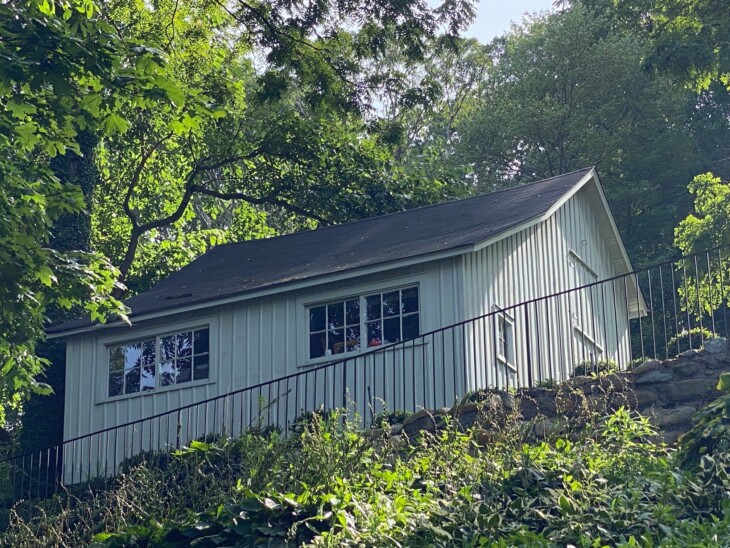Thomas Clapham Barn
58 Glen Avenue, Roslyn
Project Files
- 1932-Street-Road-Property-Ownership-Map-Roslyn-Roslyn-Harbor-Glenwood-Landing-Greenvale-East-Hills-Roslyn-Heights.pdf
- National-Register-of-Historic-Places-Documentation-Form-Roslyn-Harbor-June-24-1999.pdf

Adapted from the 1994 House Tour Guide (Page 801)
The Thomas Clapham Barn was re-located from its original site at 63 Grove Street, Glenwood Landing, in late 1991 to the Caleb Valentine site in Roslyn so that it could serve as an appropriate garage for the similarly re-located John F. Remsen House. However, the Thomas Clapham Barn was not related to the present house at 63 Grove Street which is later than the Clapham barn.
In 1869, the land comprising the present 61 Grove Street and 63 Grove Street were part of a holding owned by Benjamin and Resina Mott. On May 10th 1869 the Motts conveyed this land to Thomas Clapham who had a large farm in Glenwood Landing, of which the above was a part. Thomas Clapham was a noted boatbuilder who built a large stone house in Roslyn Harbor in 1868, which had been designed by Jacob Wrey Mould (TG 1993). Clapham was the designer and builder of the internationally known "Nonpareil Sharpie" or Roslyn Yawl," and the even smaller "Clapham Scow," both during the late 19th century. The Nassau County Tax Assessor estimates the construction date of the house at 61 Grove Street to be 1875-1876, with which it is architecturally compatible.
This house, at 61 Grove Street, probably was built for a farm employee and the barn under discussion probably was related to that house, rather than to 63 Grove Street which was not there at the time the barn was built. In addition the present boundary line between 61 and 63 Grove Street was only about 2 feet from the original east wall of the barn. Inasmuch as the loading bay in the east gable field was inaccessible after the separation of No's 61 and 63 Grove Street, and a new west loading bay had to be constructed, it may be assumed that the Clapham Barn originally was built for the present 61 Grove Street, at the same time as the house, in 1875-1876.
On 8/9/1881 Thomas Clapham divided the property and conveyed the present 61 Grove Street to Rachel Girth (Liber 581, page 433), but retained ownership of the site of the present 63 Grove Street which included the barn. Subsequently, Thomas Clapham got into financial difficulties over the lot at the present 63 Grove Street, and the barn which stood upon it (and probably considerably more farmland) became the subject of a legal action, conducted by Referee Levi A. Fuller, between George and Julia Clark as guardians of Alice, Elizabeth, Lena, Julia and Audrey Cranford and Thomas Clapham. As the result of this action the land at 63 Grove Street, and the barn, was conveyed to John Gallagher (Liber 1024, page 406).
On 9/27/1901 John and Bridget Gallagher conveyed the land at 63 Grove Street to Stephen W. Mott (Liber 37, page 263) and on 2/7/1903 Stephen W. Mott conveyed the property to Oscar Wiggins (Liber 37, page 348). Oscar Wiggins and his wife Elsie, owned the property for 44 years. They probably built the present house at 63 Grove Street, and are known to have added substantially to the original west side of the barn.
The earlier (original south extension) probably was added during the Clapham ownership (1869-1894) or by John Gallagher (1894-1901).
On 9/10/1947 Oscar J. and Elsie F. Wiggins sold the lot, house and barn to Donald Joseph and Barbara Miller Rogers (Liber 3412, page 582) and on 10/11/1949 Donald and Barbara Rogers conveyed the property to George Pickering and Florence Canning (Liber 3948, page 44). On 5/17/1991 George Pickering and Florence Canning Pickering conveyed the property to George Pickering (Liber 10144, page 390). During George Pickering's sole ownership the lot was divided (7/23/91 and 10/1 /91). After this division the barn was re-located to its present site, south of the John Remsen House, and a new house was built, more or less on its original location.
0 Comments